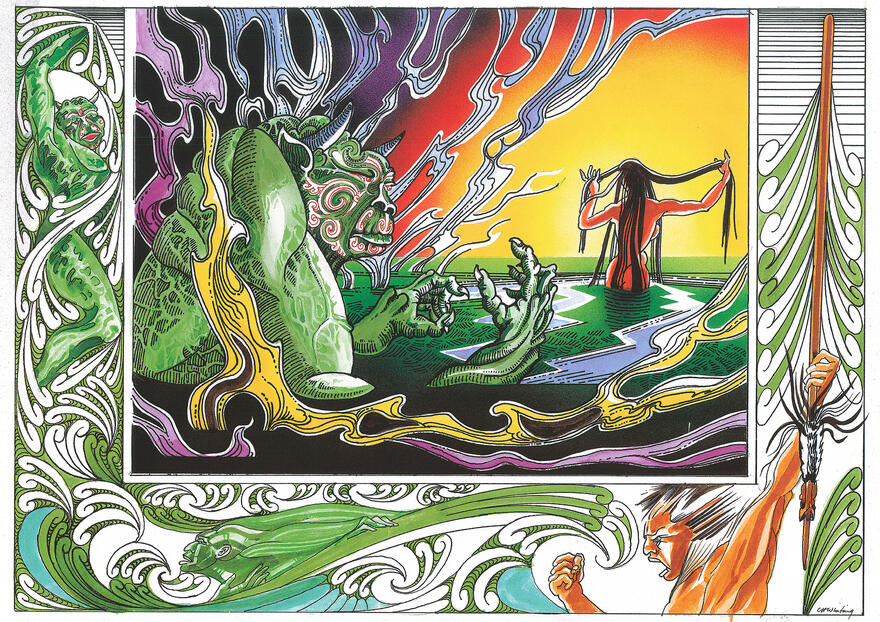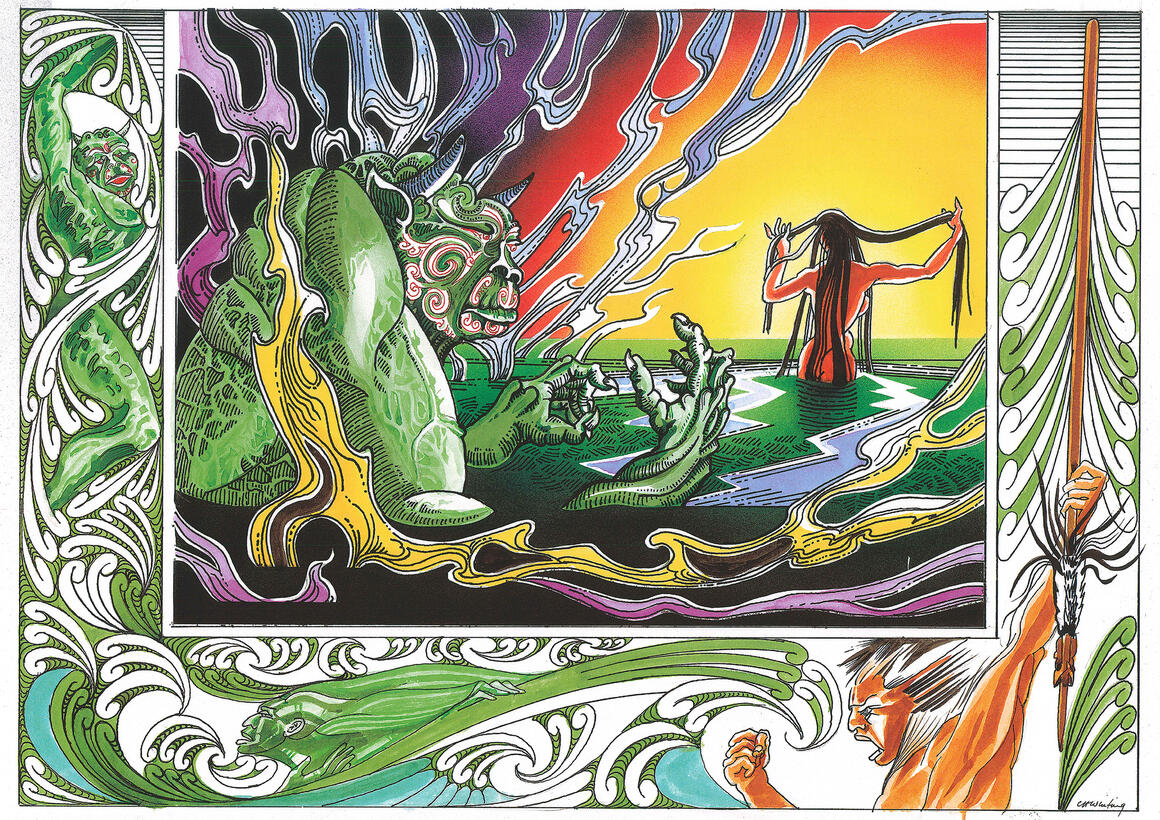Poutini is the name of the taniwha swimming up and down the West Coast of the South Island protecting both the people and the spiritual essence or mauri of pounamu, greenstone. Poutini guards the mauri within the treasured stone. The mana or spiritual force of pounamu comes from Kahue (or Ngahue), an atua. Poutini as protector of the stone is the servant of Kahue. Poutini once abducted a woman, Waitaiki, from the North Island and fled south pursued by her husband. He hid with his captive in the bed of the Arahura River but Waitaiki's husband pursued them. Poutini transformed Waitaiki into his own spiritual essence — pounamu — and fled down river to the sea. Waitaiki became the 'mother lode' of all pounamu. The husband went home grieving. The Poutini Ngāi Tahu is the calling given to Kāti Waewae, the section of Ngāi Tahu connected to the West Coast.


Poutini was a taniwha, a giant water being. He was guardian for Kahue (Ngahue), the atua or deity of pounamu, greenstone. The only being that Poutini feared was another taniwha named Whatipū, the guardian for Hinehōaka, the atua of hōaka, sandstone. Grinding with sandstone 'knives' was the only way the tūpuna could cut the tough pounamu stone.
Once, when Poutini was being pursued in the oceans by Whatipū, he took refuge in a shady corner of a bay at Tūhua (Mayor Island). It was early morning. Lying quietly in the still morning water, Poutini saw a beautiful woman coming down to the water's edge to bathe. Her name was Waitaiki. He watched as she removed her clothes and slipped into the sea. He lusted after her.
Disregarding the danger of being discovered by his enemy, Whatipū, he slipped through the waters of the bay and with a swirl of water — and not a sound — he caught Waitaiki and fled with her across the sea towards the mainland.
Meanwhile, back at Tūhua, Waitaiki's husband, Tamāhua, woke and called to his wife. No answering call came and, disturbed, he went looking for her. He found her clothes at the water's edge and knew that some dreadful fate had befallen her. Distraught, he went to his tūāhu (place of ritual) and sought to discover her fate by the powers of karakia (incantation) and divination. He used a tekateka to gain the knowledge he sought. A tekateka is a small, dart-like spear. He hurled it in the air and it hung there quivering and pointing to the mainland in the direction taken by Poutini and his beautiful captive, Waitaiki. Rushing to his canoe, Tamāhua paddled off in pursuit.
Poutini had stopped at Tahanga on the Coromandel Peninsula and lit a fire on the beach to warm Waitaiki. Then he fled across the land to Whangamatā on the western shore of Lake Taupō where he lit another fire for Waitaiki. Meanwhile, Tamaāhua landed on the beach at Tahanga and discovered the fire, but the ashes were cold. Using his tekateka again to divine the direction of his quarry, he took off in pursuit, eventually arriving at Whangamatā. He discovered the remains of the second fire and, again resorting to use of his tekateka, travelled on in pursuit of Poutini and Waitaiki, still ignorant of what had happened or who was involved.
The chase went on — fires and tekateka at every pause. To Rangitoto or D'Urville Island, to Whangamoa in the hills above Whakatū (Nelson) and to Onetāhua or Farewell Spit. Then down the western coast of the South Island to Pāhua near Punakaiki and on past Māwheranui, past Taramakau and Arahura, right to Mahitahi where the tūpuna when travelling south left the land and took to the sea using canoes. As he crossed the mouth of the Arahura River, Tamāhua noticed the water was not as cold as the water of other rivers he had been crossing, but he was too hot in pursuit to waste time — the tekateka was drawing him southwards.
By canoe he paddled south from Mahitahi to Takiwai at the mouth of Piopiotahi, Milford Sound. Here he found the tekateka hovering in the air and pointing back along the route he had just come. Frustrated and angry, he headed north again following the tekateka. It paused, waiting for him, at the mouth of the Arahura River, where he had noted the water was warmer on his journey south. By incantations he knew that his beloved Waitaiki was in distress up the Arahura River valley. He prepared himself, as a warrior, for battle.
Poutini was indeed hiding in the upper Arahura River, by a stream which flows into the main river. That stream we call today Waitaiki. He knew, because he was of the atua, that Tamaāhua was coming up river, prepared to kill him. He knew he had little chance of escape should he be found, but he did not want to leave his beautiful captive. Deciding that if he couldn't have her then no-one else would either, he changed her into his own essence — pounamu — and laid the woman-stone in the bed of the river, just by the junction of the stream now called Waitaiki with the main river. Then he slipped silently away downstream, right past the wrathful husband, Tamāhua, striding up intent on destruction. Poutini swam to the coast and ever since he has cruised its waters as the kaitiaki, guardian spirit, of the land and its sacred stone.
That is why the coast is known as Te Tai Poutini, 'the tides of Poutini'.
Tamaāhua found his beautiful wife Waitaiki. She was lying in her final bed, all grey-green and smooth — īnanga stone. He began to tangi for her and for himself at his loss. When his tangi was complete he looked around him and named two hills, Tūhua after his island home, and another Tamāhua after himself. He then began the long return journey whence he had come. He married another woman and had many children and is known in the traditions of several tribes of the Coromandel coast/northern Bay of Plenty region.
Ever since those ancient times, when the winter snows melt in spring and the waters tumble down the wild Arahura gorges, pieces of pounamu are broken off the great body of Waitaiki and make their way down the riverbed. These are the uri, children, of Waitaiki, the mother lode of the stone and the parent of the mauri that lies within pounamu.
This story is really an oral map of the ancient quarries from which the tūpuna took their valued stones. Tūhua gave them Mayor Island obsidian, a volcanic glass with its own special colour; Tahanga was the great quarry for basalt used in making adzes; Whangamatā takes its name from matā, the ordinary black obsidian. The obsidians were used for sharp knives — the throw-away razor blades of those times.
Rangitoto, D'Urville Island, is the site of the huge quarries where pākohe, metamorphised argillite, was cut from the land. Pākohe was taken too from the high hill Whangamoa. Onetāhua, Farewell Spit, is where 'floater' stones from the Nelson mineral belt are washed up in convenient sizes for shaping into tools and ornaments. The Pāhua flints are found embedded in limestone near Punakaiki. These were specially valued for drilling holes in pounamu. Takiwai at Piopiotahi, Milford Sound, was the quarry for bowenite jade, a soft, translucent stone valued for ornaments but useless for tools because it is not tough and hard like pounamu — the tungsten steel of our tūpuna. The finest pounamu lies in the bed of the Arahura River.
In the story of Poutini are summarised the findings of the first 'geological survey' of New Zealand.
Place names from the Poutini story
| Waitaiki | (Stream of) Waitaiki |
|---|---|
| Te Tai Poutini | The tides of Poutini |
| Tūhua | (Hill of) Tūhua |
| Tamaāhua | (Hill of) Tamaāhua |
Stone sources linked in the Poutini story
| Tūhua | Mayor Island | (obsidian) |
|---|---|---|
| Tahanga | Tahanga | (basalt) |
| Whangamatā | Whangamatā | (obsidian) |
| Rangitoto | D'Urville Island | (argillite) |
| Whangamoa | Hills above Nelson | (argillite) |
| Onetāhua | Farewell Spit | (argillite) |
| Pāhua | Pāhua | (flint) |
| Takiwai | Piopiotahi (Milford Sound) | (bowenite) |
| Arahura | Arahura | (pounamu) |
Reproduced courtesy of the New Zealand Geographic Board copyright.